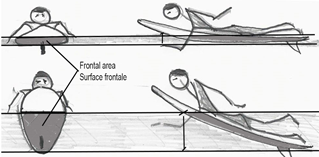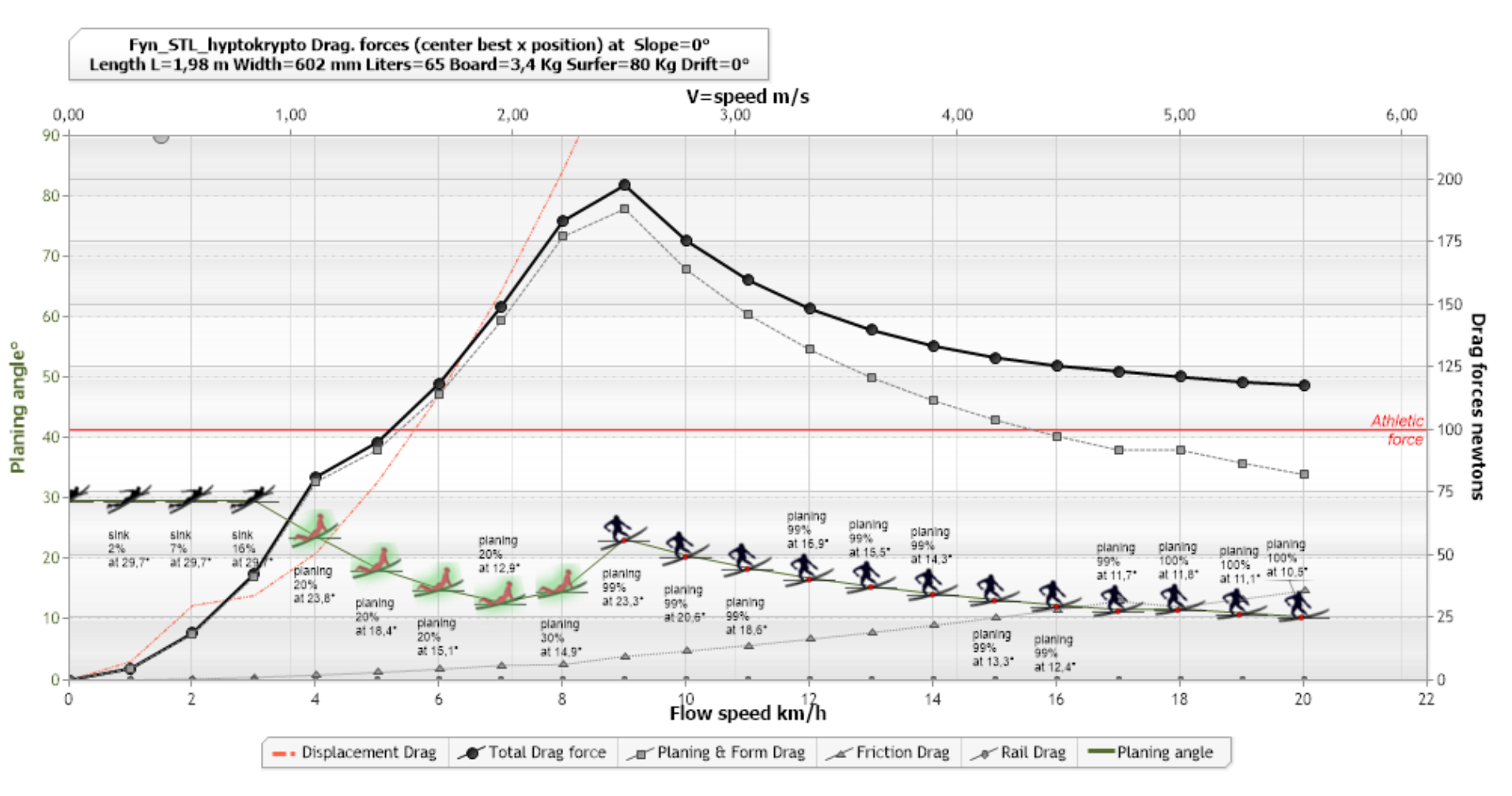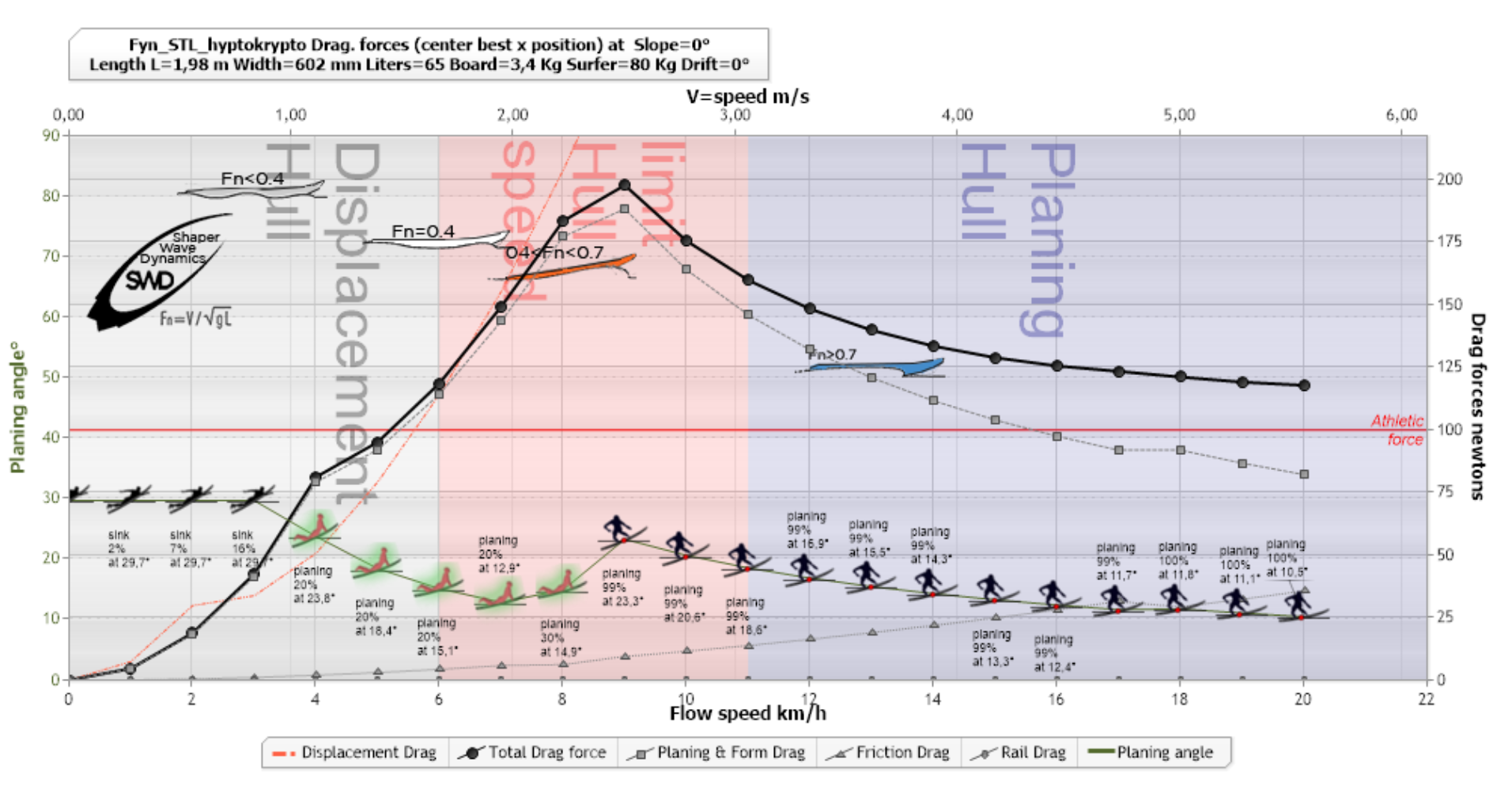The speed of a surfboard is determined by its resistance to progress, its hydrodynamic drag. If the hydrodynamic drag force is greater than the thrust force exerted, the board slows down, if the thrust is greater than the hydrodynamic force, the board accelerates. If the thrust is equal to the drag, the speed remains constant. Propulsive forces are relatively simple to assess for surfing, they depend mainly on gravity and the weight of the surfer depending on the slope, and the traction exerted, either by rowing or by other means such as a sail or a jet. ski tractor.
The study of hydrodynamic drag is central to the prediction of surfboard performance. This hydrodynamic drag is composed of two types of forces that need to be distinguished:
- Form drag :
Form drag is the force of resistance to advancement produced by the deformation of the fluid forced to circumvent the submerged form of the hull. This force depends on the frontal surface exposed to the fluid current, a very horizontal gliding position generates a smaller frontal surface than a position with a large angle of incidence, this results in a minimal form of drag when the incidence is minimum:

- friction drag. The friction drag results from the viscosity of the fluid which generates friction in contact with the wet surface, we detail the friction drag on: friction drag surf

Here is an example of the variation of hydrodynamic drag (friction + form) as a function of speed, showing the variation in incidence and displacement rate:
The angle of attack curve is marked with surfer silhouettes indicating the displacement regime. There are three types of movement:
- "sink":the surfer is moving submerged, with a maximum angle of incidence, the form resistance curve is strongly increasing and depends on the submerged volume and the oar incidence
- "planing" with a percentage lower than 100%: transient phase or planing relieves the weight of the surfer a little by reducing the submerged volume and the steepness of the shape drag curve
- "planing" with a percentage around 100%, the weight is fully supported by the planing force and relieves the drag of its displacement component (the orange dotted curve represents an evolution of the displacement drag without planing for comparison)
The friction drag (grey curve with triangle dots) evolves quite regularly as a function of the speed, on the other hand, the shape drag (gray curve with square dots) undergoes the 3 regimes of variations described above.
The particularity of planing hulls lies in the fact that they go from a fully submerged displacement regime, to a semi-submerged one and end up in planing depending on the speed. This results in a variable submerged volume and a form of drag evolving in a non-linear manner.
The various displacement regimes of ships have been widely studied, in particular by Froude, who associates the regime of resistance to progress with the formation of accompanying waves. Froude introduces a component of the global drag called "wave resistance" This drag results from the creation of wave fields around floating ships, it varies with the Froude number which determines the type of displacement of a ship :![]()
 Low speed: the accompanying waves have a wavelength lower than the submerged length of the board (Λ<L) there are several waves along the waterline. When there are 2 or more waves along the board it can be assumed that the wave resistance is negligible. The friction resistance is then 60% to 90% of the total drag. This is the case for the rowing phase Fn ≈0.18, beyond which the wave resistance increases. (Presles, 2005)
Low speed: the accompanying waves have a wavelength lower than the submerged length of the board (Λ<L) there are several waves along the waterline. When there are 2 or more waves along the board it can be assumed that the wave resistance is negligible. The friction resistance is then 60% to 90% of the total drag. This is the case for the rowing phase Fn ≈0.18, beyond which the wave resistance increases. (Presles, 2005)
 When the speed increases (powerful paddling) the wavelength of the accompanying waves increases until reaching the waterline length. The board is then carried by a single wave forming a crest at the front and a crest at the rear: This corresponds to the Froude number of 0.4, it is the theoretical hull speed limit. To increase the speed the surfer must go up the crest wave that he creates, and inject a lot of energy. A long board therefore offers, in addition to the buoyancy reducing the submerged frontal surface, a higher theoretical hull speed limit.
When the speed increases (powerful paddling) the wavelength of the accompanying waves increases until reaching the waterline length. The board is then carried by a single wave forming a crest at the front and a crest at the rear: This corresponds to the Froude number of 0.4, it is the theoretical hull speed limit. To increase the speed the surfer must go up the crest wave that he creates, and inject a lot of energy. A long board therefore offers, in addition to the buoyancy reducing the submerged frontal surface, a higher theoretical hull speed limit.
 When the speed limit of the hull is exceeded, the rear wave moves away, and the front of the board rears up on the crest wave according to the angle α and generates a very significant resistance..
When the speed limit of the hull is exceeded, the rear wave moves away, and the front of the board rears up on the crest wave according to the angle α and generates a very significant resistance..  Wave resistance then becomes predominant (about 70% to 85% of the total drag). It will be necessary to go up the slope of the wave to move up a gear, to plan.
Wave resistance then becomes predominant (about 70% to 85% of the total drag). It will be necessary to go up the slope of the wave to move up a gear, to plan.
• When Fn is above 0.7, which is largely the case in surfing, the hull is planing, the front part comes out of the water and only a small part of the board is submerged. This is planing, the wave resistance is then negligible. To conclude with the Froude number and wave resistance: In surfing, when planing, the wave field drag is negligible, because Fn>0.7.
When Fn is above 0.7, which is largely the case in surfing, the hull is planing, the front part comes out of the water and only a small part of the board is submerged. This is planing, the wave resistance is then negligible. To conclude with the Froude number and wave resistance: In surfing, when planing, the wave field drag is negligible, because Fn>0.7.
ShaperWaveDynamics software can display Froude number values for comparison:

It can be seen that the drag peak corresponds to the Froude values describing the limit hull speed between the Froude numbers 0.4 and 0.7.
The shaper can analyze in detail the behavior of the resistance to progress for a board model of his choice, and vary the parameters of volume and size to adjust his shape according to the weight of the client.
But this analysis of the resistance drag allows us to introduce a notion of take-off slope limit which highlights the effectiveness of a board in a given wave, for a given surfer. We are going to study the take off limit slope on the page: Take off analysis, the take off limit slope